2. Experimentation as a
Learning Method:
A Case Study Exploring Affordances of a Musical Instrument
© 2024 Fausto Pizzol, CC BY-NC 4.0 https://doi.org/10.11647/OBP.0398.03
Introduction
Artistic research typically starts out from a creative challenge. For a bass player, the conventional understanding of the instrument could in itself be a limitation, given its monophonic characteristic, typically with an accompanying role. The possibility of exploring a different understanding of the instrument’s potential for polyphonic and harmonic playing became the impetus for my entry into artistic research in music, and an exploration characterised by artistic method development. Looking for a method to learn, develop, and systematise the study of this potential, I adopted the concept of affordances1 and a theory derived from it, called perceptual learning and development.2 Artistic research is a way for me to develop systematic approaches to initiate artistic development and design the path to new creative insights.
From immersion in the perspectives of affordance theory and perceptual learning, I created a research design meant to conduct experiments on the possibilities of playing vertical harmonies on the electric bass. These experiments were expanded to include simultaneous execution of harmony and melody, a technique known as the chord-melody style of playing. In this sense, this chapter exposes the research that I made to learn, develop, and systematise this unconventional use of the instrument, as well as a discussion about affordances and perceptual learning and its use in music research. Along with these main goals, I suggest that the method I create should be tested by other musicians who want to explore unconventional ways to play their instruments. Implementing these tests should be the next step in this work in progress.
Alongside the method based on the concept of affordances and perceptual learning and development theory, this research has its theoretical musical contents based on the LCCTO—Lydian Chromatic Concept of Tonal Organization.3 The choice of the LCCTO concept as a musical foundation has to do with its emphasis on the relationship between chords and scales, which places it in line with this work. Applying its premises through the proposed research design led to the creation of a harmonic vocabulary for the electric bass, containing a chord dictionary, a thesaurus of patterns articulating chords and scales, and compositions organised as studies, called creative applications.
Affordances
The term ‘affordances’ was coined in the 1960s by James Jerome Gibson (1904–1979) within the scope of Ecological Psychology, a field in which the psychologist and his wife Eleanor Jack Gibson (1910–2002), another relevant name for this study, were pioneers. A concise definition of ecological psychology is given by Lorena Lobo, Manuel Heras-Escribano, and David Travieso:
[…] is an embodied, situated, and non-representational approach pioneered by J. J. Gibson and E. J. Gibson. This theory aims to offer a third way beyond cognitivism and behaviorism for understanding cognition. The theory started with the rejection of the premise of the poverty of the stimulus, the physicalist conception of the stimulus, and the passive character of the perceiver of mainstream theories of perception. On the contrary, the main principles of ecological psychology are the continuity of perception and action, the organism-environment system as a unit of analysis, and the study of affordances as the objects of perception, combined with an emphasis on perceptual learning and development. 4
J. Gibson aimed to present an innovative perspective for understanding perception and perceptual learning that would overcome the dichotomies of perception/action, organism/environment, subjective/objective, and mind/body characteristics of predecessor theories.5 In this context, he developed the concept of affordances, defending the idea of mutualism in the relationship between the organism and the environment in the perception of possibilities of action. The author defines affordances in this way:
The affordances of the environment are what it offers the animal, and what it provides or furnishes, either for good or ill. The verb to afford is found in the dictionary, but the noun affordance is not. I have made it up. I mean by it something that refers to both the environment and the animal in a way that no existing term does. It implies the complementarity of the animal and the environment.6
Deepening his concept, J. Gibson states that the behaviours of individuals, in the sense of action, depend on the knowledge they obtain through the perception of the affordances of the environment.7 Such perception is the result of a direct process, which begins with the detection of specific information from the environment, such as patterns and regularities, which are named invariants.8 Rejecting the idea of perception as a passive process, Pablo Covarrubias, paraphrasing J. Gibson, points out that the animal actively seeks information through exploratory movements.9 The authors Luke Windsor and Christophe de Bézenac exemplify: ‘(...) a pen might afford writing (...). A pen will be a shape that fits the hand, exudes a coloured liquid, which can mark a surface: to discover these properties would require exploration, a key element of ecological psychology.’ Interpreting J. Gibson, the same authors use their own words to define the concept of affordances, and, in my opinion, create a simple and clarifying version: ‘An affordance is a property of an event or object, relative to an organism, which represents its potential for action.’10 Another equally interesting statement about the concept of affordances is put forward by Agnes Szokolszky:
This mutualist concept [affordances] captures the codeterminate character of functional meaning in the O-E [organism-environment] system. A given environment offers directly perceivable possibilities for action, and agents take advantage of these possibilities, which have intrinsic relational value, and therefore are directly meaningful, in a situated way. 11
Although the definition of affordances proposed by J. Gibson is considered very broad by some researchers, giving rise to several interpretations,12 he describes the detailed study undertaken over almost two decades that gave rise to it and offers a wealth of examples of what it synthesises. Considering that his main interest is related to the perception of the environment by human beings, J. Gibson argues the following four things:
The theory of affordances is a radical departure from existing theories of value and meaning. It begins with a new definition of what value and meaning are. The perceiving of an affordance is not a process of perceiving a value—free physical object to which meaning is somehow added in a way that no one has been able to agree upon; it is a process of perceiving a value—rich ecological object. Any substance, any surface, any layout has some affordance for benefit or injury to someone. Physics may be value—free, but ecology is not […]. The medium, substances, surfaces, objects, places, and other animals have affordances for a given animal. They offer benefits or injury, life or death. This is why they need to be perceived. The possibilities of the environment and the way of life of the animal go together inseparably. The environment constrains what the animal can do […]. Within limits, the human animal can alter the affordances of the environment but is still the creature of his or her situation.
An affordance cuts across the dichotomy of subjective-objective and helps us to understand its inadequacy. It is equally a fact of the environment and a fact of behaviour. It is both physical and psychical, yet neither. An affordance points both ways, to the environment and to the observer.
[W]hat we perceive when we look at objects are their affordances, not their qualities. We can discriminate the dimensions of difference if required to do so in an experiment, but what the object affords us is what we normally pay attention to.
The affordance of something does not change as the need of the observer changes. The observer may or may not perceive or attend to the affordance, according to his needs, but the affordance, being invariant, is always there to be perceived. An affordance is not bestowed upon an object by a need of an observer and his act of perceiving it. The object offers what it does because it is what it is.13
Regarding the relationship between music studies and the concept of affordances and perceptual learning and development, I highlight three texts that dialogue with this work: (1) Adnan Marquez-Borbon (2009) ‘Perceptual Learning and the Emergence of Performer-Instrument Interactions with Digital Music Systems’;14 (2) Simon Waters (2007): ‘Performance Ecosystems: Ecological approaches to musical interaction’;15 (3) Luke Windsor and Christophe de Bézenac (2012): ‘Music and Affordances’.16
Waters discusses the notion of a performance ecosystem, focusing on the performer-instrument-environment interrelationship within the scope of electroacoustic music. Important for the present work and in line with E. Gibson’s theory that will be discussed later, he points out the mutation in this interrelationship as potentiated by engagement in exploratory activities of a perceptual nature. Another point of dialogue between Waters’s and the present work is his framing of musical instruments as tools, from an ecological perspective:
It enables us to deal with the instrument as a tool, instrument as prosthesis (mimetic, relating to a perceived ‘lack’, and integral to a specific body), instrument as sensor (and thus integral to our intersensoriality), and instrument as a measure of engagement […]. It allows us to acknowledge that precise acoustic conditions and aggregates of bodies have been critical for much musicking […].17
Marquez-Borbon investigates the interaction between performers and digital musical instruments from the perspective of perceptual learning and development. He points out:
[…] as the performer learns to play the instrument, they attune their perception to the multiple capacities of the system and are capable, in some instances, to perceive new possibilities that may yield possible paths towards the development of new musical or sonic practices. Interactions, more than operating a device, are represented by a rich history of engagement in which the performer develops a deep understanding of the system and what it may artistically afford. It is suggested that achieving this aim can be prompted by the introduction of alternative learning or pedagogical strategies that go beyond traditional music conservatory pedagogy. These multiple approaches invest in the development of other creative musical skills, such as improvisation, listening, and collaboration, which are often ignored by the dominant Western music tradition.18
Marquez-Borbon uses key terms for the theory of perceptual learning and development of new affordances: attune, perception, interactions, engagement. These terms will take part in this work when exposing the method adopted for carrying out the proposed experiments.
The text by Windsor and de Bézenac points out a way to understand the relationships between musicians and their musical instruments in the creation of new affordances: ‘[...] instruments can have different affordances when in the hands of individuals with different or deliberately changed effectivities.’19 The authors add:
In fact, many musical traditions incorporate actions that deliberately go against the characteristics of the instruments that are used. Musicians often go to great lengths to overcome bodily and instrumental constraints in order to achieve particular aesthetic or functional goals (e.g., learning lines that are characteristic of another instrument or instrumentalist). In this process, musicians change their effectivities through the development of new perceptual sensitivities and levels of motor complexity.20
In line with the above statement, the contemporary practice of the electric bass, in the aspect explored here, incorporates actions that deliberately go against the characteristics of its conventional practice. The new affordances of this aspect involve the development and systematisation of techniques and mechanisms to create a harmonic vocabulary for the instrument. Then, this vocabulary is used in the creation of artistic interventions, materialised in the form of musical compositions that approach the electric bass as a harmonic instrument.
Continuing the discussion about the use of the concept of affordances in this work, I begin by framing the electric bass in one of the categories of ecological objects listed by J. Gibson (that is, medium, substances, surfaces, objects, places, and other animals), namely, objects. Within this category, there is also a subdivision: attached objects and detached objects. The electric bass falls into the latter.
The affordances of what we loosely call objects are extremely various. It will be recalled that my use of the terms is restricted and that I distinguish between attached objects and detached objects […]. Detached objects must be comparable in size to the animal under consideration if they are to afford behavior. But those that are comparable afford an astonishing variety of behaviors, especially to animals with hands. Objects can be manufactured and manipulated. Some are portable in that they afford lifting and carrying, while others are not […].21
The definition of the characteristics of the electric bass through the perception of the affordances of the instrument, as this is being done, does not aim to reclassify or give it a new name. Rather, the objective is to declassify it from established practice, pointing out broader characteristics that may contribute to the perception of new affordances. In this logic, the electric bass, being a musical instrument, can still be characterised within one of the categories of detached objects, a tool. This last characterization has already been mentioned before when quoting Waters and portrays a personal perception that, in part, motivated the beginning of this investigation. I believe that the electric bass (as well as other musical instruments) can be approached beyond the established paradigm for its practice, starting from the conception that it is only a tool for musical expression, that is, a musical object at its disposal of creativity.
Using ecological psychology terms, this proposal of exploring the affordances of the electric bass beyond conventional practice (melodic/monophonic), and approaching the instrument as harmonic/polyphonic, reflects my perception that this musical tool enables (‘affords’) the individual, in this case, myself, specific and potentially prolific actions in this regard.22 This proposal is supported by J. Gibson’s statement about the perception of the affordances of a detached object:
To Perceive an Affordance is not to Classify an Object
The fact that a stone is a missile does not imply that it cannot be other things as well. It can be a paperweight, a bookend, a hammer, or a pendulum bob. It can be piled on another rock to make a cairn or a stone wall. These affordances are all consistent with one another. The differences between them are not clear-cut, and the arbitrary names by which they are called do not count for perception. If you know what can be done with a graspable detached object, what it can be used for, you can call it whatever you please. The theory of affordances rescues us from the philosophical muddle of assuming fixed classes of objects, each defined by its common features and then given a name. As Ludwig Wittgenstein knew, you cannot specify the necessary and sufficient features of the class of things to which a name is given. They have only a ‘family resemblance’. But this does not mean you cannot learn how to use things and perceive their uses. You do not have to classify and label things in order to perceive what they afford.23
Once this initial framework is made, the development of the harmonic affordances of this detached object-tool, the electric bass, is based on a complementary theory, or extension,24 of James Gibson’s concept, the notion of perceptual learning and development, developed in parallel by Eleanor Gibson.25 Her theory seeks to explain the process of learning and developing new affordances according to the ecological psychology paradigm. Therefore, based on the concept of affordances, the work proposed here seeks, in conjunction with the theoretical/musical content of the LCCTO, to develop the harmonic potential of the electric bass through the application of J. Gibson and E. Gibson’s theory and its ramifications, as detailed next.
Perceptual Learning and Development
In the context of ecological psychology, ‘perceptual learning refers to the basic epistemic process of how the perceptual system becomes sophisticated in the detection of novel and relevant aspects of the environment and thereby becomes able to guide action in ever changing contexts’.26 According to E. Gibson, learning and development take place through processes of adjustment of the individual’s behaviour in accordance with the information available in the environment. She calls these processes ‘attunement’ and ‘calibration’.27 The authors Lobo, Heras-Escribano, and Travieso clarify:
The ecological approach to perceptual learning aims to explain how perceivers take advantage of the specific and redundant information available in the ambient energy arrays (E. J. Gibson, 1969; E. J. Gibson and Pick, 2000). This is, perceptual learning has to do with the processes of attunement and calibration. First, organisms must engage into an attunement process (to learn how to detect specific information for affordances); second, they need to adjust their behavior to an informational variable (a calibration process).28
Exploration is placed as an essential procedure for this process of learning and development of new possibilities of action and, according to E. Gibson, such procedure involves engaging in activities of perception of different natures, such as visual, oral, or haptic (tactile system). The author also points out the influence of mental processes and social context in detecting information for affordances.
Still on the importance of the exploratory procedure according to the bias of ecological psychology, Marquez-Borbon observes the construction of new knowledge and, consequently, new affordances:
Consistent with E. J. Gibson’s description of information pickup, performers
engaged in exploratory actions to reveal information about the system. Additionally, performatory actions where participants engaged in a process of expectation and confirmation contributed to yielding new knowledge and further spurred exploration […]. E. J. Gibson observes that as action capabilities change (i.e, sensorimotor skills), new affordances can be learned. In effect, in developing skills one also develops or attunes their perception to the environment.29
In this logic, E. Gibson, considering that the perceptual development that leads to the learning of new affordances is driven by a complex interaction between the environment and human motivation, describes the behavioural aspects that contribute to such development. These can be summarised as follows:
Agency: Self-control, intentionality in behaviour. Agency is learning to control both one’s own activity and external events.
Prospectively: Intentional, anticipatory, playful, future-oriented behaviours […] Tendency to see order, regularity, and pattern to make sense of the world.
Flexibility: Perception can adjust to new situations and bodily conditions (such as growth, improved motor skills, …).30
A more recent development of E. Gibson’s proposal involves a theory called ‘direct learning’. This approach seeks to reveal the regularities in the learning path, which is characterised as an information-driven process. The theory relies on the possibility that learning is a direct event, rather than one based solely in cognitive processes.31 Inspired by the concept of affordances and perceptual learning and development, it details a set of behavioural processes that imply a change in perception (learning) and actions guided by perception. They are:
Education of Intention: ‘[…] one of the functions of intention is to set up perceptual or perceptual-motor systems to detect a particular informational variable.’32 This variable is called the ‘specifying variable’, and, as the name suggests, it is a variable that specifies the property that an observer intends to perceive. David Jacobs and Claire Michaels state that certain perceptions and actions, among many possible ones, are more beneficial than others and, with experience, the individual can improve the choice of which of these he or she intends to update.33 Regarding the importance of intentions in the exploratory learning process, Jacobs and Michaels point out:
Ecological studies therefore often proceed by choosing situations in which a particular intention can be assumed. In catching experiments, for instance, it is generally assumed that perceivers intend to catch balls and not to hit or to avoid balls. Such assumptions are necessary because intentions define task situations, for instance—and this is important for the remainder of the article—assuming a particular intention is required to define and identify specifying and non specifying variables.34
Education of Attention: J. Gibson addressed the importance of educating attention for the detection of relevant variables. In his opinion, this is an active process wherein the individual seeks to concentrate on the most useful informational variables.35 Attention, which guides perception, is understood as the driving force in the detection of information.36 It can be understood that, perception, continuously guided by attention to an intentionally selected variable (education of intention), can be redirected by new events or information towards new and more useful variables.37 ‘Education of attention is an action-based process, involving research and active exploration.’38
Calibration: Although Jacobs and Michaels have created a quantitative approach to the calibration process, something that the present work does not intend to adopt, this process also points to behaviours that can be approached qualitatively. I refer to the perception-action loop: (1) ‘perceptual systems orient the perceptual organs and make adjustments in the exploration to resonate when ecological information is picked up’;39 (2) the circularity in the interaction between new motor skills and new possibilities of action: ‘New motor skills bring new action possibilities;40 and (3) the refinement of the education of intention and education of attention processes, which can feed back into each other. Jacobs and Michaels state: ‘[…] the sophistication of expert performance derives from the improved fits of experts to their environments […].’41
Based on these ecological psychology principles discussed so far, I propose a method to guide artistic experiments aimed at developing new affordances (harmonic in nature) for the electric bass and creating a harmonic vocabulary, as summarised in the research design42 below.
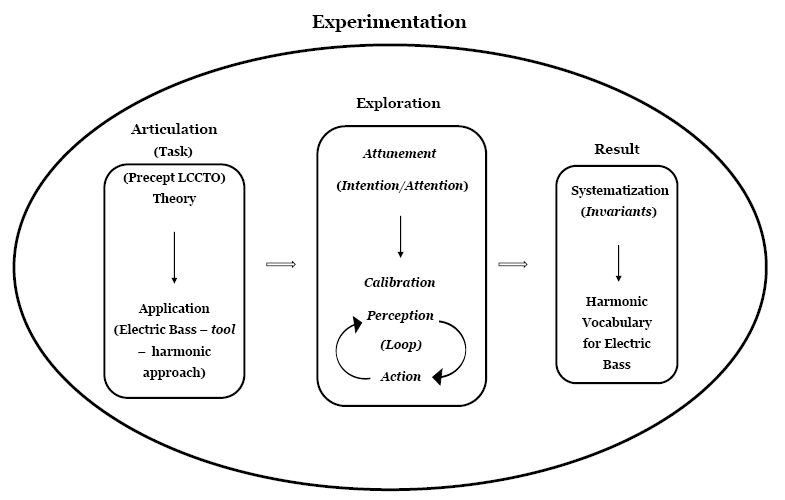
Fig. 2.1: Research design summarising the method adopted for the empirical experiments
Conducting the Experiments
The artistic experiments are divided into three groups. Each of these groups was conceived with the aim of structuring a harmonic vocabulary for the electric bass. The three groups are:
- First Group—Detection of possibilities to play the chords proposed in the LCCTO, on the electric bass. (Generating chapter 1 of the harmonic vocabulary: chord dictionary)
- Second Group—Detection of possibilities for harmonising the LCCTO’s principal scales on the electric bass. (Generating Chapter 2: thesaurus of patterns articulating chords and scales)
- Third Group—Harmonic relationships between the chords from the harmonic fields of the principal scales of the LCCTO. (Generating Chapter 3: harmonic relationships between chords)
The exposition of the method of conducting the experiments will be done through commentary on examples. There will be three examples, one for each group of experiments.
1st Group—Detection of Possibilities to Play the Chords Proposed in the LCCTO, on the Electric Bass
The first group of artistic experiments focuses on the exploration of ways of performing, on the electric bass, the chords from the harmonic fields suggested in the LCCTO. To register such execution forms, diagrams representing the scale of the instrument will be used (Fig. 2.2).

Fig. 2.2: Diagrams for four and five-string electric bass.
Attunement
Between pages 23 and 28 of George Russell’s reference book on the LCCTO is presented the score notation of the principal chords (chord mode) and sub-principal chords constructed from each of the degrees of the Lydian Scale. Each group of chords proposed for a certain degree is treated as a premise, and different possibilities of playing these chords on the electric bass are explored. As an example, for the #IV degree of the harmonic field of the Lydian Scale, the following harmonic structures are placed:
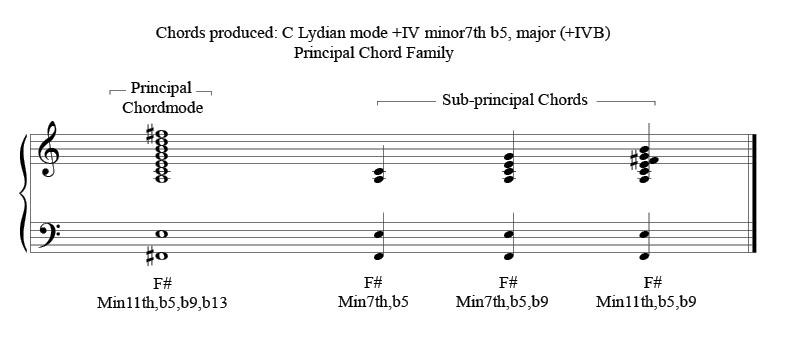
Fig. 2.3: Lydian Mode +IV Minor Seventh b5/Major(+IVb) – Principal Chord Family. From Russell, p. 27.
The first suggested sub-principal chord is F#min7(b5), composed by the notes F Sharp (T), A (b3rd), C (b5th), E (b7th). The score notation is the starting point of the experiment, and represents, in relation to the proposed research design, the theory component to be applied to the practice of electric bass (task). Then begins the attunement process, wherein the intention (education of intention) is to play the chord exactly as specified in the author’s score on the electric bass, that is, at the same pitch and with the same interval order. Therefore, the education of attention is focused on locating, visually and tactilely, the ergonomic possibilities of executing said harmonic structure. As a result of this perceptual exploration, the following forms of execution were detected for the F#Min(b5) chord, as represented in the diagrams, Fig. 2.4a–p, below:

Fig. 2.4a. Possibility of performing the same harmonic structure proposed by the LCCTO.

Fig. 2.4b. Possibility of performing the same harmonic structure/execution form an octave higher.
Calibration
Starting the second process, calibration, it is possible to detect other ways of executing the F#min7(b5) chord by adjusting the perception for new informational variables. The chord in question is formed by the notes F#, A, C, E, which are repeated in different locations of the electric bass scale.
Keeping F sharp as the lowest sound of a harmonic structure composed of four notes, it is possible to create different voicings by varying the order of notes A, C, E, as well as the height (frequency) and position, in the scale, of all the four notes. By calibrating attention to these variables, the perception-action loop is fed, revealing new execution possibilities, ergonomically and sonically viable.43 As a result of this exploratory process, the following forms of execution were detected:
|
|
|
|
|
Fig. 2.4c. |
Fig. 2.4d. |
Fig. 2.4e. |
|
|
|
|
|
Fig. 2.4f. |
Fig. 2.4g. |
Fig. 2.4h. |
The execution forms registered so far were gradually perceived in visual, tactile, and aural ways, through the exploration of the instrument’s scale and from each new piece of information detected. Each form of execution produced information for the progress of the experiment, resulting, in a cyclical way, in the perception of new forms. The next process, as dictated by the research design, is the systematisation of the results.
The implemented systematisation proposal aims to facilitate the learning and internalisation of the results of the experiments practically and logically. For this purpose, systematisation is divided into two stages: (1) initial, aimed at organising the results associated with each experiment, and (2) final, encompassing the set of results of all experiments, originating the harmonic vocabulary for the electric bass. The systematisation stage that will be exposed below fits as initial, that is, it represents the organisation of the results of the experimentation of the possibilities of execution in the electric bass of the F#min7(b5) chord. The systematisation of the results of this one, as well as of the other experiments of detection of possibilities of execution of the chords proposed in the LCCTO, takes place through the grouping of the diagrams of each chord explored according to its highest note (leading tone). This higher note constitutes the invariant44 of systematisation chosen by me. Following this logic, the F#min7(b5) chord diagrams are organised as follows:
Systematization
F#Min7th b5 chord with minor 3rd (A) as Leading Tone:
|
|
|
|
Fig. 2.4i. |
Fig. 2.4j. |
F#Min 7th b5 chord with diminished 5th (C) as Leading Tone:
|
|
|
|
|
Fig. 2.4k. |
Fig. 2.4l. |
Fig. 2.4m. |
|
|
|
|
Fig. 2.4n. |
Fig. 2.4o. |
F#Min 7th b5 chord with minor 7th (E) as Leading Tone:

Fig. 2.4p.
Fig. 2.4 (a–p): Diagrams representing execution forms for the F#Min(b5) chord.
The choice of systematisation based on the invariant highest note (leading tone) reflects prospective behavioural conduct.45 Anticipating a future behaviour, this initial systematisation proposal will help the following artistic work, which deals with the articulation of scales and, subsequently, melodies, with the chords that are now being studied. In this reasoning, the chord forms detected and systematised are added to the harmonic vocabulary and made available for harmonising scales and melodies. For each degree of a given scale, there is a set of diagrams available, where the highest note of the voicing represents the note of the melody to be harmonised.
For clarification purposes, I present a brief video example (Video 2.1) of this articulation which is covered in detail in specific experiments. In this example, a Lydian melody is harmonised with the chord from the first-degree in root position and inversions.

Video 2.1. Video of author presenting CMaj triad and inversions, uploaded by Fausto Lessa, 14 February 2022, https://hdl.handle.net/20.500.12434/c7435c81
Second Group—Detection of Possibilities for Harmonising the LCCTO’s Principal Scales on the Electric Bass. (Articulations between Chords and Scales)
The exploration to be carried out in this second group of experiments aims to produce theoretical knowledge and develop technical skills related to the simultaneous execution of melodic lines and harmonic accompaniment on the electric bass. Qualitatively, possibilities of harmonising on the electric bass will be experimented with involving articulations between the principal scales of the LCCTO and chords from their respective harmonic fields. The five chord categories listed by Russell were experimented with, namely: Major, Minor, Dominant, Augmented, and Diminished.46
Referring to the proposed research design, the theory/practice articulation of this entire group of experiments takes place through the application of the chord/scale relational content, as presented in the LCCTO, to the harmonic approach of the electric bass. In the case of this particular experiment, the theory concerns the harmonisation of the C Lydian diminished Scale using the C diminished triad.
Attunement
In the attunement process, where exploration begins, the aim is to detect a viable possibility of executing already registered forms (diagrams) of the diminished triad suggested by Russell (closed position), simultaneously with the execution of the Lydian Diminished Scale. Inversions are also contemplated.
In my view (intention/attention), the first perceptibly viable possibility is the execution of the Lydian Diminished Scale in ascending and descending forms, with block harmonisation of the notes that belong to the diminished triad of C.47 The result of this initial exploration is listed below (Video 2.2 and Fig. 2.5). 48

Video 2.2. Video of author presenting the harmonisation of Lydian Diminished Scale notes belonging to the first degree triad—closed position, uploaded by Fausto Lessa, 5 February 2022, https://hdl.handle.net/20.500.12434/df0f8785
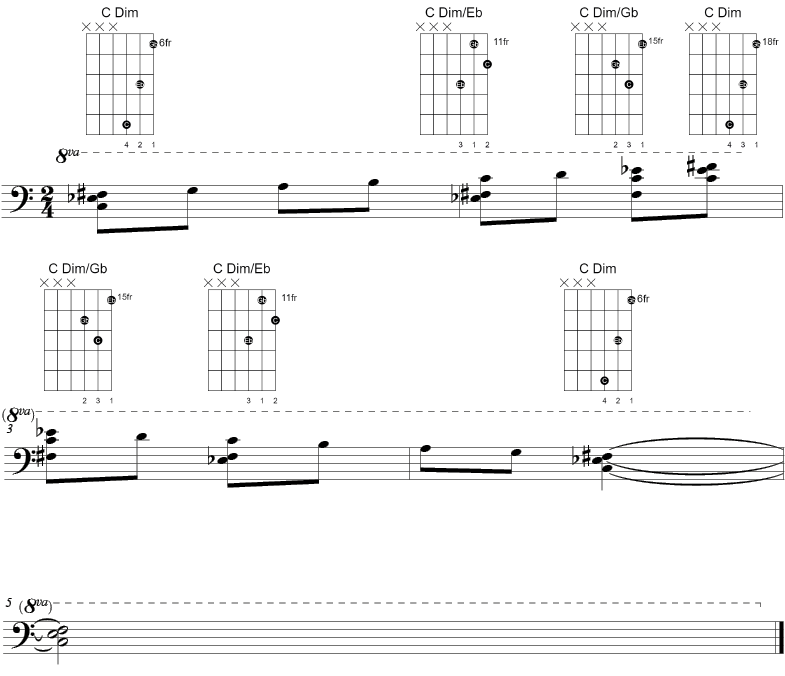
Fig. 2.5: Harmonising the notes of the Lydian Diminished Scale that belong to the first—degree triad—closed position.
Calibration
In the calibration process, possibilities of harmonising the scale are explored using different voicings of the diminished triad. In addition to harmonising the notes of the triad, I also sought to detect viable ways of harmonising the other notes of the scale. This harmonisation results in the construction of chords with sixth, seventh, or triads with an added note (add).

Video 2.3. Video of author demonstrating the harmonisation of all notes of the Lydian Diminished Scale with the first-degree triad—closed position, uploaded by Fausto Lessa, 5 February 2022, https://hdl.handle.net/20.500.12434/e6c0b76e
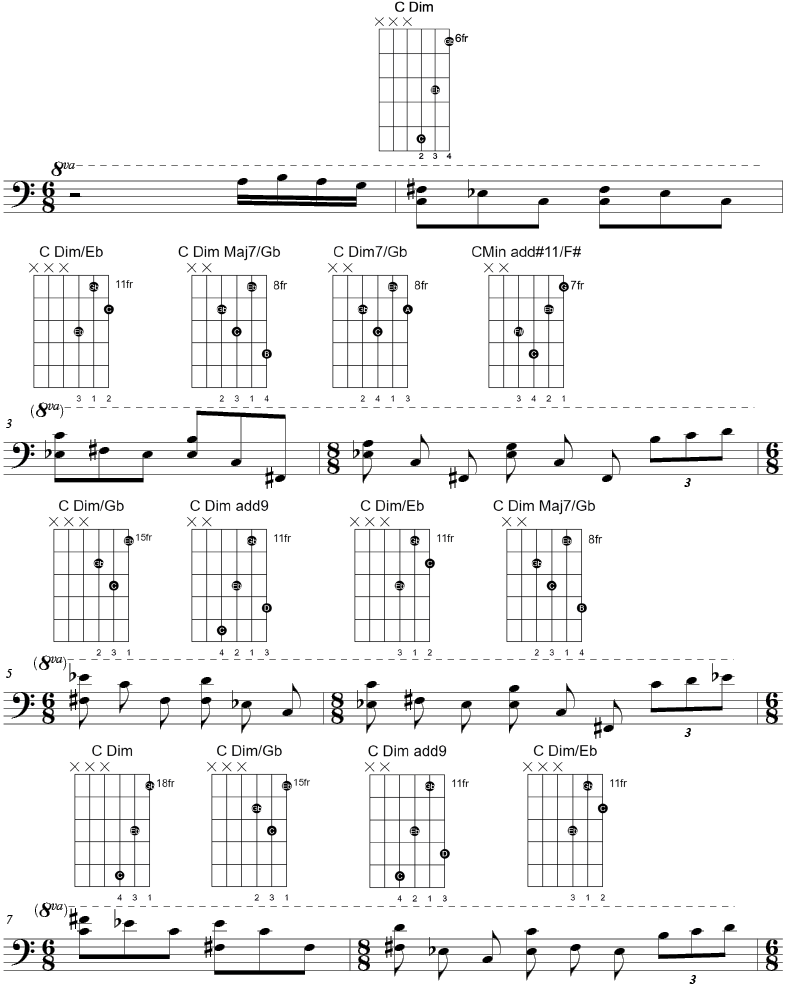
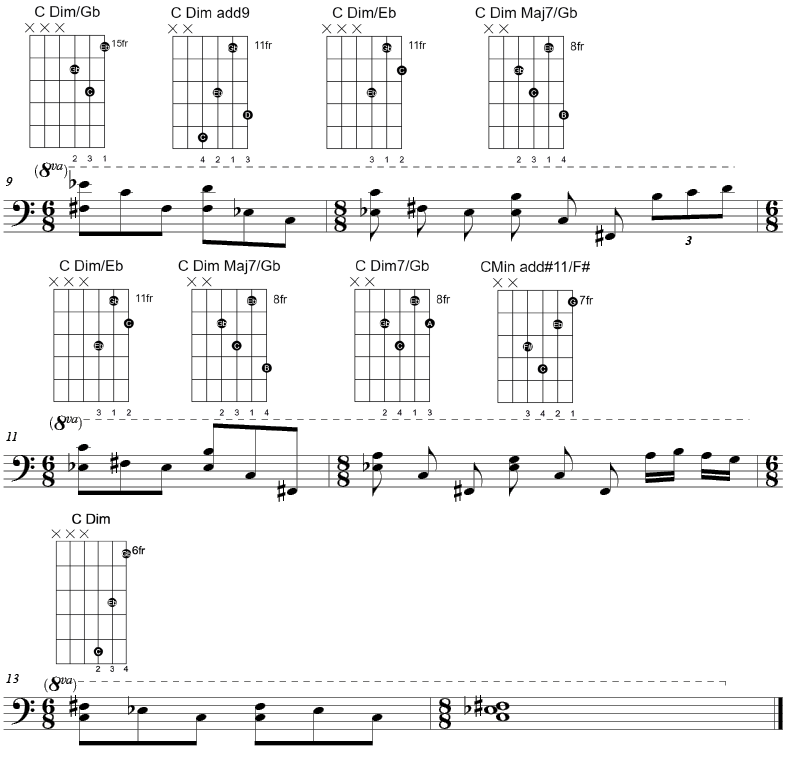
Fig. 2.6: Harmonizing all notes of the Lydian Diminished Scale with the first-degree triad – closed position.
Harmonisation of all Notes of the Lydian Diminished Scale with the First-Degree Triad—Drop 2 Position
The execution of the chords listed below proved to be unfeasible in the drop 2 position. As an alternative to continuing the exploration, these same chords were executed in closed position:
- Cdim/Gb with A as the highest note of the voicing
- Cdim Maj7/Gb with B as the highest note of the voicing
- Cdim add9 with D as the highest note of the voicing
- CMin add#11/F# with G as the highest note of the voicing

Video 2.4. Video of author demonstrating the harmonisation of all notes of the Lydian Diminished Scale with the first degree triad—drop 2 position, uploaded by Fausto Lessa, 5 February 2022, https://hdl.handle.net/20.500.12434/0cb2636e
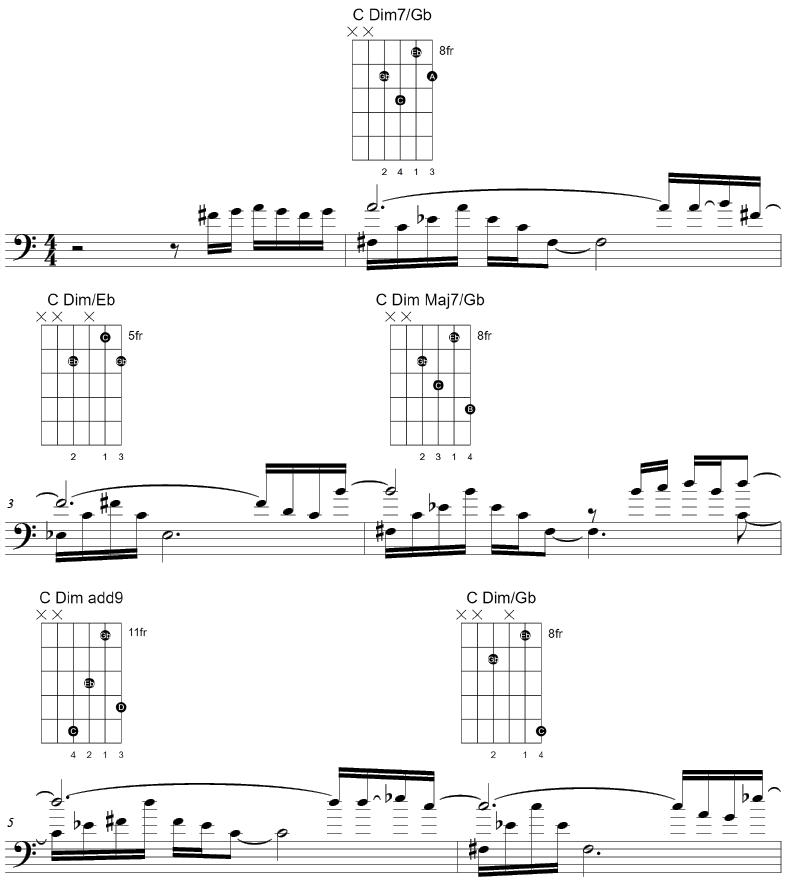
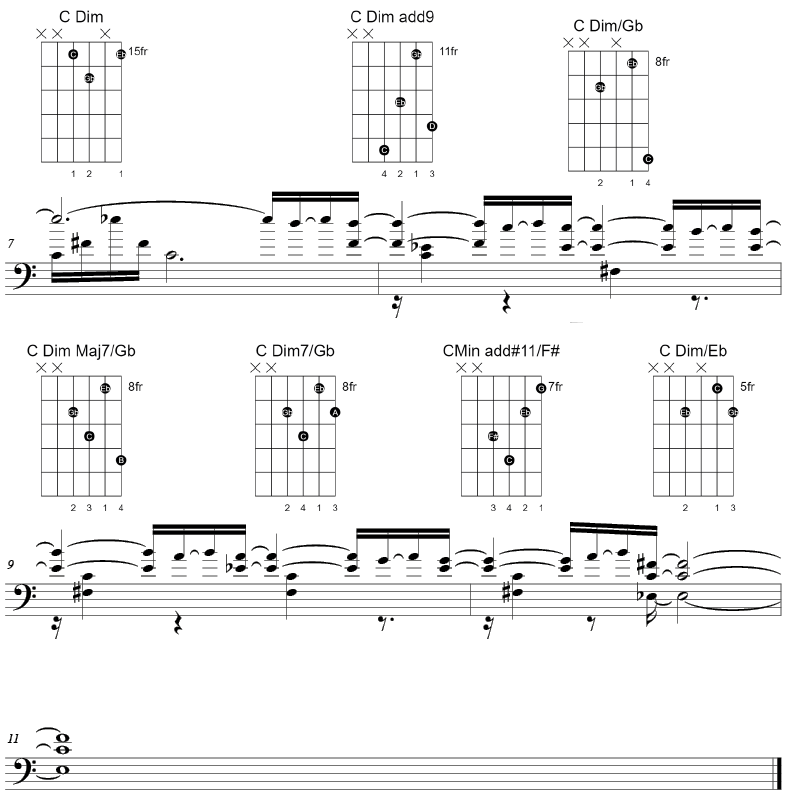
Fig. 2.7: Harmonising all the notes of the Lydian Diminished Scale with the first—degree triad—drop 2 position.
Execution of the Lydian Diminished Scale, on More than one String, Accompanied by Harmonisation with the First-Degree Triad—Open Position
Another possibility explored was the execution of the scale accompanied by the chord. After having harmonised the notes individually in the previous explorations, the perception/action loop led my practice toward the search for possibilities of executing phrases or melodic motifs accompanied by their harmonisations. One way I found to make the study of this new affordance viable and systematic was to use the scale, with beginning and end in different degrees in each measure, contemplating all seven degrees. With the mastery of this affordance, that is, possessing the technical ability to execute this discovered potential, it becomes possible to freely manipulate the scale to create different melodies and harmonise them.

Video 2.5. Video of author executing the Lydian Diminished Scale, on more than one string, accompanied by harmonisation with the first degree triad—open position, uploaded by Fausto Lessa, 5 February 2022, https://hdl.handle.net/20.500.12434/0874b874
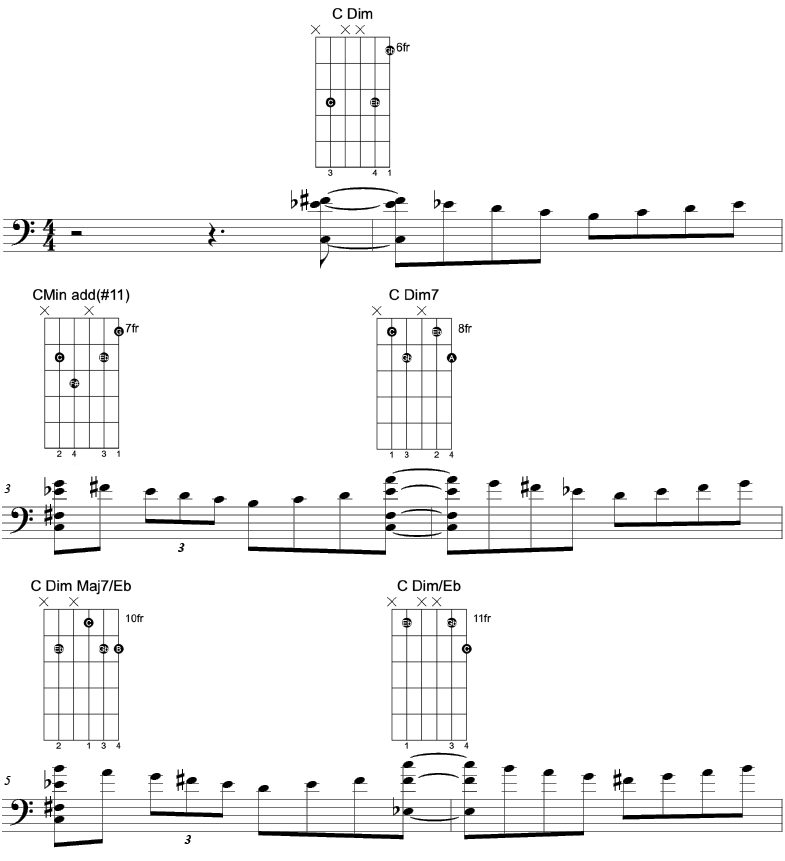

Fig. 2.8: Execution of the Lydian Diminished Scale, on more than one string, accompanied by harmonisation with the first-degree triad – open position.
After exposing the exploration of the possibilities of harmonising the Lydian Diminished Scale, two observations can already be made. The first concerns the dimension that the work could take if the possibilities were explored to the point of exhaustion. Opportunely, these experiments have a qualitative bias, to detect relevant aspects to produce the necessary knowledge to build a consistent vocabulary for the harmonic performance of the electric bass. In this sense, based on the experiments, the three positions explored—closed, drop 2, and open—prove to provide the content required for this purpose.
The second observation refers to the research design, more specifically to the calibration process and the subsequent systematisation of results based on invariants. By feeding the perception-action loop with the result of the first exploration, the search for new affordances was directed towards moving the notes away from the voicings gradually and in an organised way. As a consequence of this procedure, invariant elements were naturally imposed that can be taken as a reference for systematisation. I am referring, again, to the positions of the triad, that is: closed, drop 2, open. Therefore, based on the two observations, I defined that the experiments of the second group would have as one of the delimitation and systematisation criteria these previously defined positions, which proved to be viable and adequate when applied to the harmonic approach of the electric bass.
I believe it is reasonable to state that the results obtained so far with this Lydian Diminished Scale harmonisation experiment constitute a qualitatively satisfactory collection of viable execution possibilities to be added to the proposed harmonic vocabulary. Therefore, once this experimentation is over, I find that in addition to the previously selected invariants, associated with the chord position (closed, drop 2, open), a second set of invariants has imposed itself, contributing to the efficient complementation of the delimitation and systematisation of the results. I refer to the sequence of explorations generated by the perception-action loop. In this sequence, the following order of procedures was outlined, which was then adopted in the other experiments of this group: (1) harmonising only the notes of the scale that belong to the chord being explored; (2) harmonising all notes of the scale with the chord being explored; (3) execution of the scale, fragment, motif or rhythmic/melodic pattern thereof, in more than one electric bass string, accompanied by harmonisation with the chord being explored. In this logic, the delimitation and process of systematisation of the results of each experiment in this second group can be illustrated from two complementary sets of invariants, as outlined below.

Fig. 2.9: Delimitation scheme of the experiments of the second group.
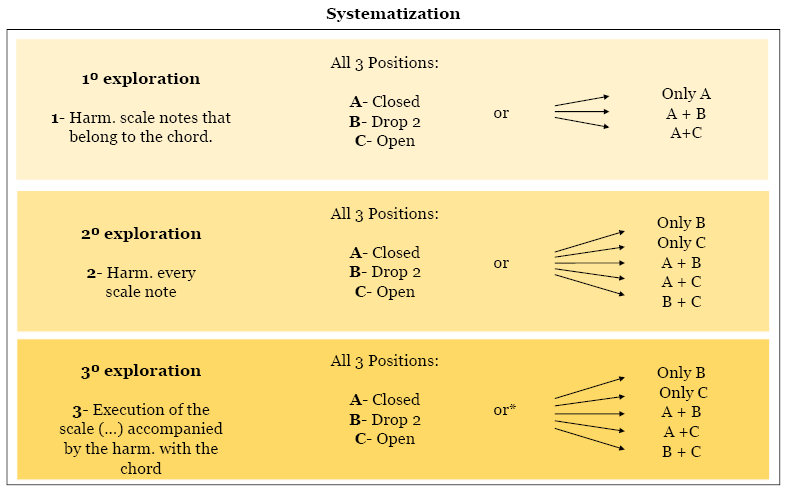
*If ≠ 2nd exploration.
Fig. 2.10: Scheme of systematisation of the experiments of the second group.
Thus, regarding systematisation, if all explorations of a given experiment are ergonomically viable, the set of results obtained will contemplate the exploration of all positions and forms of articulation defined by the two sets of invariants that make up the delimitation.
Creative Application
The proposed creative application intends to use the contents resulting from the experiments in the form of composition. As an example, the creative application of the results of experiments with dominant chords articulated with the Lydian Dominant Scale will be exposed below.
This creative study has the C Lydian Flat Seventh Scale as its central tonality and is based on the articulation between melodies elaborated from this scale and the dominant tetrad formed by the harmonisation of its first-degree. However, chords of the dominant type (flat seventh) from different degrees and/or belonging to other tones and harmonic fields are used. This intentional use of different contents and assumptions of the LCCTO in the same composition is in line with what was previously defined in my research, in the sense of favouring and gradually intensifying the transversality of the addressed subjects. In this logic, the composition has dominant chords such as G7sus4 (measure 14) and G7(#5) (measures 14 and 15), coming respectively from the harmonic fields of the Lydian scale (second-degree) and Lydian Flat Augmented (fifth degree augmented). It also has chromatic passages in the melody and a Lydian major seventh chord in C#maj7/9(#11).
The musical instrument used to record the composition was a five-string electro-acoustic bass. In contrast to the solid body of the conventional electric bass, the instrument has a resonance box that adds a peculiar tone to the instrument, even with the traditional electric pickup and electronic circuit. Another differential of the electroacoustic bass is its strings, composed of a metallic alloy formed mainly by bronze. The tuning used, starting from the highest string, follows the order: C, G, D, A, E.

Video 2.6. Video of author demonstrating the creative application: articulation between the Lydian Flat Seventh Scale and the dominant chord of the first degree, uploaded by Fausto Lessa, 5 February 2022, https://hdl.handle.net/20.500.12434/56e02acf
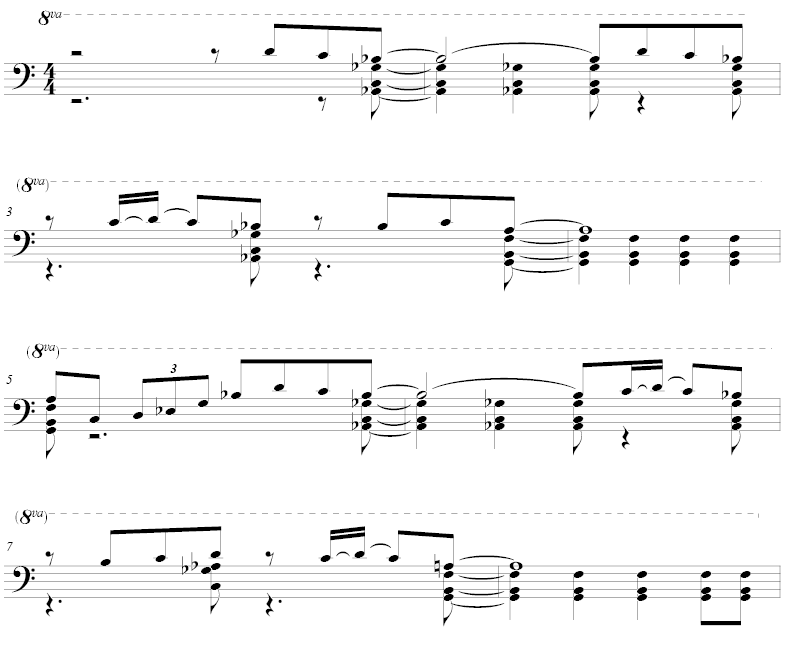

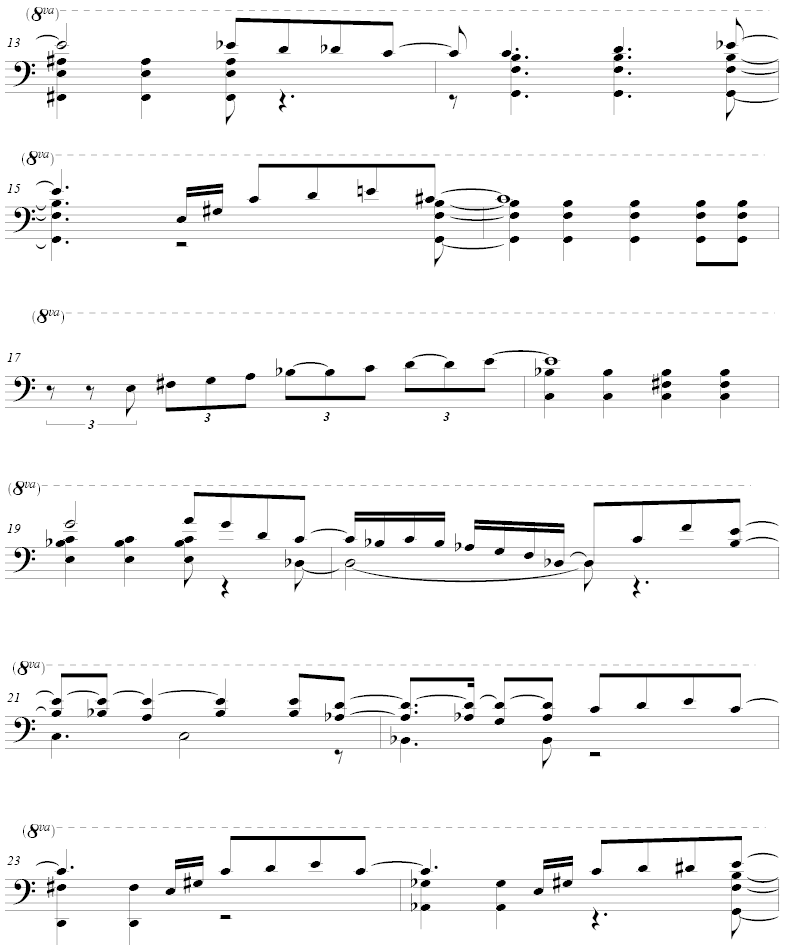
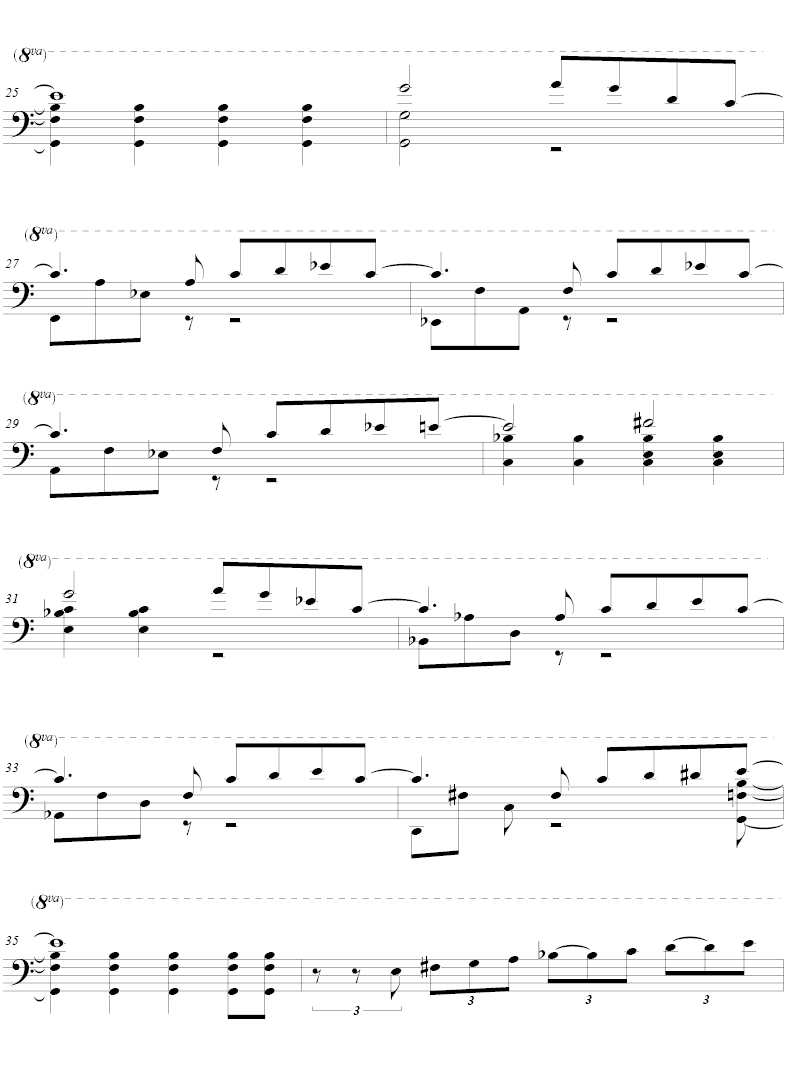
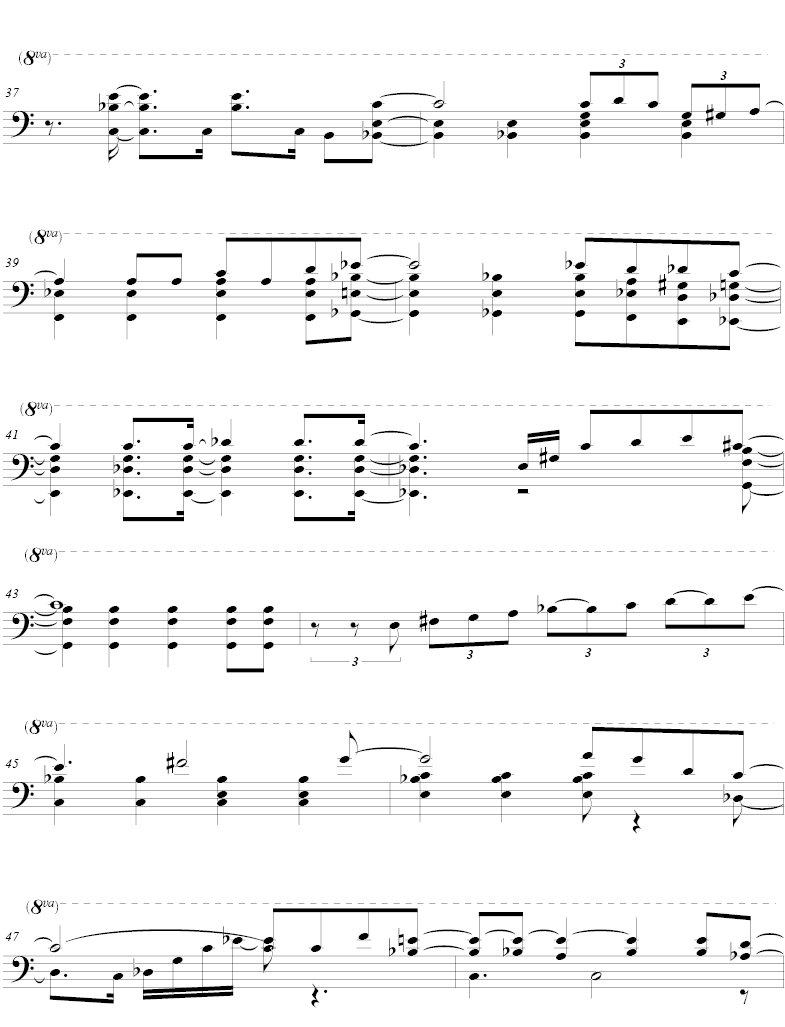
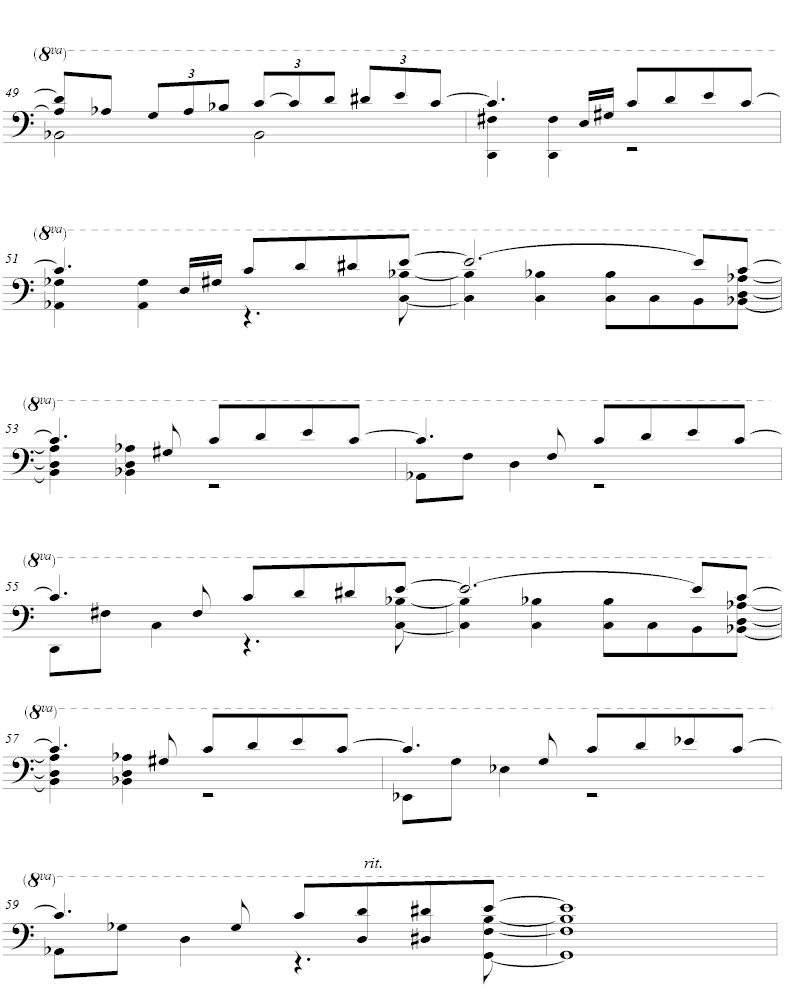

Fig. 2.11: Creative application: results from the articulation between the Lydian Flat Seventh Scale and the dominant chord of the first degree.
Third Group—Harmonic Relationships between the Chords from the Harmonic Fields of the Principal Scales of the LCCTO
The harmonic relationships were explored in two fashions. The first was between chords from the same primary modal tonic degree of the different principal scales of the LCCTO. The second was between chords from different degrees and scales, exploring the alternate and conceptual modal tonic degrees, according to LCCTO. The example shown next deals with the chords from primary modal tonic I.
Referring to the research design, the first procedure is to choose the premise to be articulated with the harmonic approach of the electric bass. In this exemplification, it will be the harmonic relationship between the primary modal tonic chords. From the statement of this task begins the attunement process. The intention was to play, in a sequence established by the tonal-gravity principle (from close to distant), each chord and principal scale of the first degree, aiming to display and internalise their sonority.
Attunement

Video 2.7. Video of author demonstrating the articulation between LCCTO’s principal scales and chords from the first degree—closed position, uploaded by Fausto Lessa, 16 May 2022, https://hdl.handle.net/20.500.12434/3636d83c
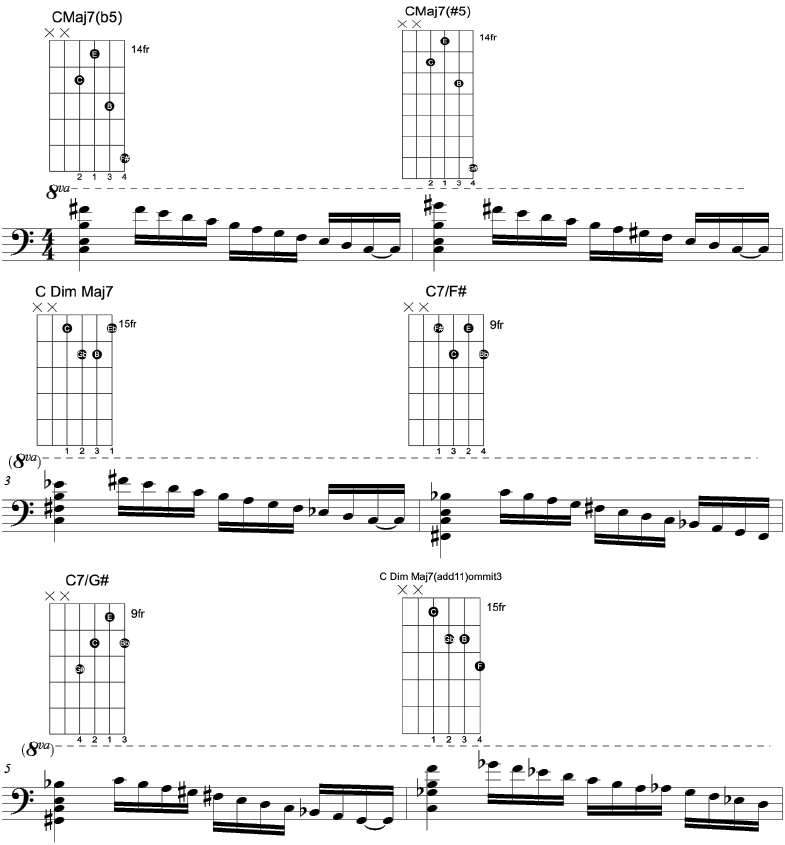
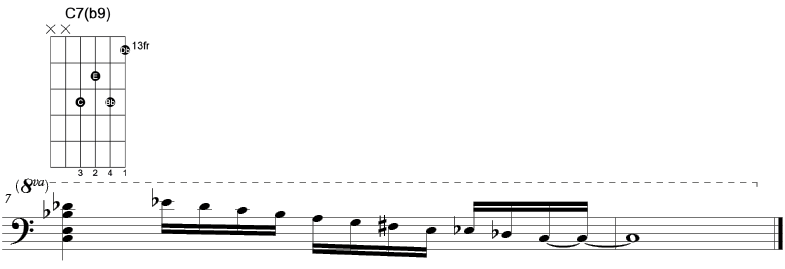
Fig. 2.12: Articulation between LCCTO’s principal scales and chords from the first—degree—closed position.
Having the result of this first exploration, the experiment goes to the next process, the calibration. In this process, the chords from other degrees were explored using different voicings and scale patterns. Since the chords from the first degree were explored exclusively in the closed position, the other chords will use a different voicing type or a combination of voicings. The example below (Video 2.8 and Fig. 2.13) explores the chords from the second degree in a mix of drop 2 and open position.

Video 2.8. Video of author demonstrating the articulation between LCCTO’s principal scales and chords from the second degree, uploaded by Fausto Lessa, 28 November 2022, https://hdl.handle.net/20.500.12434/35b6eccf



Fig. 2.13: Articulation between LCCTO’s principal scales and chords from the second—degree.
Each degree explored has its own creative application. The invariant for the systematisation for this group of experiments was, obviously, the scale degree. The score below portrays the result of this application for the first degree.

Video 2.9. Video of author demonstrating the creative application: results from the articulation between LCCTO’s principal scales and chords from the first degree, uploaded by Fausto Lessa, 28 November 2022, https://hdl.handle.net/20.500.12434/0dd3a1d7



Fig. 2.14: Creative Application: results from the articulation between LCCTO’s principal scales and chords from the first—degree.
Considerations and Conclusions
Applying the concept of affordances to musical practice with a focus on technical development and creation proves to be convenient and productive. The proposed research design, also based on the perceptual learning and development theory, is an instrument with potential yet to be explored and discussed.
The results of these artistic experiments, even considering the qualitative character of the explorations, were numerous. The set of results from the first group of experiments add up to more than a thousand diagrams representing ways of playing chords on the electric bass. The second and third groups of artistic experiments also bring together a considerable amount of articulation patterns between chords and scales, as well as harmonic relationships. The perception/action loop appears to be limited only by creativity, intention, and attention, thus constituting a versatile and individualised tool for musical learning and development.
The creative applications also have a didactic purpose. Initially conceived to assess the musical applicability of the results obtained in the experiments, these syntheses of the results can be seen as musical studies. From this perspective, the teaching-learning activity related to the harmonic approach of the electric bass can benefit, diverting the route from mechanical learning of repetition of exercises with scales to the path of assimilation of contents associated with musical practice, creation, and interpretation.
Finally, I believe that this material that I am producing from the artistic experiments, namely the harmonic vocabulary content for the electric bass, could have several uses: as teaching material, for those bass players who wish to learn or develop this instrument’s potential; to consolidate the position of the electric bass as a harmonic instrument; and for composers, as a reference book, if they wish to compose musical works in which the electric bass has a harmonic approach. I also think that the research design I created can contribute to investigations that propose the development of unconventional techniques (extended techniques) for playing instruments other than the electric bass.
References
Carello, Claudia and Michael T. Turvey, ‘Physics and Psychology of the Muscle Sense’, Current Directions in Psychological Science, 13.1 (2004), 25–28, https://doi.org/10.1111/j.0963-7214.2004.01301007.x
Covarrubias, Pablo, Ángel A. Jiménez, Felipe Cabrera, and Alan Costall, ‘The Senses Considered as Perceptual Systems: The Revolutionary Ideas of Gibson’s 1966 Book, 50 Years Later – part 1’, Ecological Psychology, 29.2 (2017), 69–71, https://doi.org/10.1080/10407413.2017.1297680
Fajen, Brett R., Michael A. Riley and Michael T. Turvey, ‘Information, Affordances, and the Control of Action in Sport’, International Journal of Sport Psychology, 40 (2009), 79–107
Gibson, Eleanor Jack and Anne D. Pick, Perceptual Learning and Development: An Ecological Approach (New York: Oxford University Press, 2000)
Gibson, James Jerome, The Ecological Approach to Visual Perception (Boston: Houghton Mifflin, 1979)
Jacobs, David and Claire Michaels, ‘Direct Learning’, Ecological Psychology, 19.4 (2007), 321–49, https://doi.org/10.1080/10407410701432337
Jamone, Lorenzo, Emre Ugur, Angelo Cangelosi, Luciano Fadiga, Alexandre Bernardino, Justus Piater, and José Santos-Victor, ‘Affordances in Psychology, Neuroscience, and Robotics: A Survey’, IEEE Transactions on Cognitive and Developmental Systems, 10.1 (2018), 4–25, https://doi.org/10.1109/TCDS.2016.2594134
Khatibi, Mina and Razieh Sheikholeslami, ‘Gibson’s Ecological Theory of Development and Affordances: A Brief Review’, The International Journal of Indian Psychology, 2.4 (2015), 140–44
Lee, David N., ‘General Tau theory: evolution to date’, Perception, 38.6 (2009), 837–50, https://doi.org/10.1068/pmklee
Lobo, Lorena, Manuel Heras-Escribano, and David Travieso, ‘The History and Philosophy of Ecological Psychology’, Frontiers in Psychology, 9.2228 (2018), 1–15, https://doi.org/10.3389/fpsyg.2018.02228
Marquez-Borbon, Adnan, ‘Perceptual Learning and the Emergence of Performer-Instrument Interactions with Digital Music Systems’, A Body of Knowledge (2018), 2—23, https://escholarship.org/uc/item/5p45g68p
Norman, Donald Arthur, The Design of Everyday Things (New York: Basic Books, 1988)
Richardson, Michael, J., Kevin Shockley, Brett R. Fajen, Michael A. Ryley, and Michael T. Turvey, ‘Ecological Psychology: Six Principles for an Embodied-Embedded Approach to Behavior’, in Handbook of Cognitive Science: An Embodied Approach, ed. by Paco Calvo and Tony Gomila (Amsterdam: Elsevier, 2008), 159–87, https://doi.org/10.1016/B978-0-08-046616-3.00009-8
Russell, George, Lydian Chromatic Concept of Tonal Organization: Volume 1: The Art and Science of Tonal Gravity, Fourth Edition (Brookline: Concept Publishing, 2001)
Szokolszky, Agnes, Catherine Read, Zsolt Palatinus, Kinga Palatinus, ‘Ecological Approaches to Perceptual Learning: Learning to Perceive and Perceiving as Learning’, Adaptive Behavior, 27.6 (2019), 363–88
Szokolszky, Agnes, ‘Perceiving Metaphors: An Approach from Developmental Ecological Psychology’, Metaphor and Symbol, 34.1 (2019), 17–32, https://doi.org/10.1080/10926488.2019.1591724
Travieso, David and others, ‘Dynamic Touch as Common Ground for Enactivism and Ecological Psychology’, Frontiers in Psychology, 11.1257 (2020), 1–10, https://doi.org/10.3389/fpsyg.2020.01257
Turvey, Michael T. and Robert E. Shaw, ‘Ecological Foundations of Cognition: I. Symmetry and Specificity of Animal–Environment Systems’, Journal of Consciousness Studies, 6 (1999), 95–110
Waters, Simon, ‘Performance Ecosystems: Ecological Approaches to Musical Interaction’, Electroacoustic Music Studies Network (2007), 1–20, http://www.ems-network.org/spip.php?article278
Windsor, W. Luke and Christophe de Bézenac, ‘Music and Affordances’, Musicae Scientiae, 16.1 (2012), 102–20, https://doi.org/10.1177/1029864911435734
Withagen, Rob and Margot Van Wermeskerken, ‘Individual Differences in Learning to Perceive Length by Dynamic Touch: Evidence for Variation in Perceptual Learning Capacities’, Attention Perception & Psychophysics, 71.1 (2009), 64–75, https://doi.org/10.3758/APP.71.1.64
1 James Jerome Gibson, The Ecological Approach to Visual Perception (Boston: Houghton Mifflin, 1979).
2 Eleanor Jack Gibson and Anne D. Pick, Perceptual Learning and Development: An Ecological Approach (New York: Oxford University Press, 2000).
3 George Russell, Lydian Chromatic Concept of Tonal Organization: Volume 1: The Art and Science of Tonal Gravity, Fourth Edition (Brookline: Concept Publishing, 2001).
4 Lorena Lobo, Manuel Heras-Escribano, and David Travieso, ‘The History and Philosophy of Ecological Psychology’, Frontiers in Psychology, 9.2228 (2018), 1–15 (p. 1), https://doi.org/103389/fpsyg.2018.02228.
5 Ibid., p. 1.
6 J. Gibson, p. 127.
7 See Mina Khatibi and Razieh Sheikholeslami, ‘Gibson’s Ecological Theory of Development and Affordances: A Brief Review’, The International Journal of Indian Psychology, 2.4 (2015), 140–44 (p. 143).
8 See Agnes Szokolszky, ‘Perceiving Metaphors: An Approach from Developmental Ecological Psychology’, Metaphor and Symbol, 34.1 (2019), 17–32 (p. 21), https://doi.org/10.1080/10926488.2019.1591724
9 Pablo Covarrubias, et al., ‘The Senses Considered as Perceptual Systems: The Revolutionary Ideas of Gibson’s 1966 Book, 50 Years Later—part 1’, Ecological Psychology, 29.2 (2017), 69–71 (p. 70), https://doi.org/10.1080/10407413.2017.1297680
10 Luke W. Windsor and Christophe de Bézenac, ‘Music and affordances’, Musicae Scientiae, 16.1 (2012), 102–20 (p. 3), https://doi.org/10.1177/1029864911435734
11 Szokolszky, p. 20.
12 See Lorenzo Jamone and others, ‘Affordances in Psychology, Neuroscience, and Robotics: A Survey’, IEEE Transactions on Cognitive and Developmental Systems, 10.1 (2018), 4–25 (p. 5), https://doi.org/10.1109/TCDS.2016.2594134
13 J. Gibson, The Ecological Approach to Visual Perception, pp. 140—43.
14 Adnan Marquez-Borbon, ‘Perceptual Learning and the Emergence of Performer-Instrument Interactions with Digital Music Systems’, A Body of Knowledge (2018), 2–23, https://escholarship.org/uc/item/5p45g68p
15 Simon Waters, ‘Performance Ecosystems: Ecological approaches to musical interaction’, Electroacoustic Music Studies Network (2007), http://www.ems—network.org/spip.php?article278
16 Windsor and de Bézenac.
17 Waters, p. 5.
18 Marquez-Borbon, p. 19.
19 Windsor and de Bézenac, p. 9.
20 Ibid., p. 8.
21 J. Gibson, p. 133.
22 I think it is appropriate to point out that this is a proposal considerably at odds with the canon of electric bass performance, when it comes to evaluating its current reference literature. In this sense, and in view of the results that will be presented later, I believe that this text has the potential to contribute significantly to the advancement of knowledge about the possibilities of musical application of the electric bass.
23 J. Gibson, p. 134.
24 Szokolszky, ‘Perceiving Metaphors’, p. 18.
25 E. Gibson and Pick, Perceptual Learning and Development: An Ecological Approach.
26 Agnes Szokolszky and others, ‘Ecological approaches to perceptual learning: learning to perceive and perceiving as learning’, Adaptive Behavior, 27.6 (2019), 363–88 (p. 373).
27 E. Gibson and Pick, p. 141; p. 179.
28 Lobo et al., p. 12.
29 Marquez-Borbon, p. 12.
30 See Khatibi and Sheikholeslami, p. 142. These three behavioural aspects, to some extent, resemble the deep learning guidelines discussed by Odd Torleiv Furnes in Chapter 10 of this book. However, the notion of deep learning, widespread in the field of (New) Learning Sciences, also focuses on building long-term understanding and on interdisciplinarity of contents, subjects that are not central to E. Gibson’s perceptual learning and development theory.
31 David Jacobs and Claire Michaels, ‘Direct Learning’, Ecological Psychology, 19.4 (2007), 321–49 (p. 330), https://doi.org/10.1080/10407410701432337
32 Ibid., p. 327.
33 Ibid., p. 326.
34 Ibid.
35 J. Gibson, pp. 235–43.
36 Szokolszky and others, ‘Ecological approaches’, p. 367.
37 Jacobs, ‘Direct Learning’, p. 327.
38 Szokolszky and others, ‘Ecological approaches’, p. 370.
39 Michael Richardson and others, ‘Ecological Psychology: Six Principles for an Embodied-Embedded Approach to Behavior’, in Handbook of Cognitive Science: An Embodied Approach, ed. by Paco Calvo and Tony Gomila (Amsterdam: Elsevier, 2008), pp. 159–87 (p. 174), https://doi.org/10.1016/B978-0-08-046616-3.00009-8
40 Lorenzo Jamone and others, ‘Affordances in Psychology, Neuroscience, and Robotics: A Survey’, IEEE Transactions on Cognitive and Developmental Systems, 10.1 (2018), 4–25 (p. 4), https://doi.org/10.1109/TCDS.2016.2594134
41 Jacobs, ‘Direct Learning’, p. 322.
42 This is the research design that is mentioned in the chapter introduction. Fed with theoretical data from the LCCTO (precepts), it works as a mechanism aimed at exploration and consequent generation of results related to the possibilities of harmonic execution of the electric bass.
43 This calibration process, applied as a method for exploration, based on the perception-action loop, bears some degree of similarity with the procedure for ‘creating variations’ as described by Mikael Bäckman in Chapter 3 of this book, in relation to what he calls a ‘creative process of generating licks’ for the harmonica.
44 See J. Gibson; E. Gibson and Pick.
45 For prospective behaviour, see E. Gibson and Pick, pp. 168–76.
46 Russell, p. 17.
47 I believe it is important to emphasise the personal character of this initial perception and, although it is not the object of study in this work, it seems reasonable to me to say that other musicians can suggest different approaches.
48 All results of the second group of experiments are recorded, in addition to the score, with the support of diagrams and respective audios and videos.













